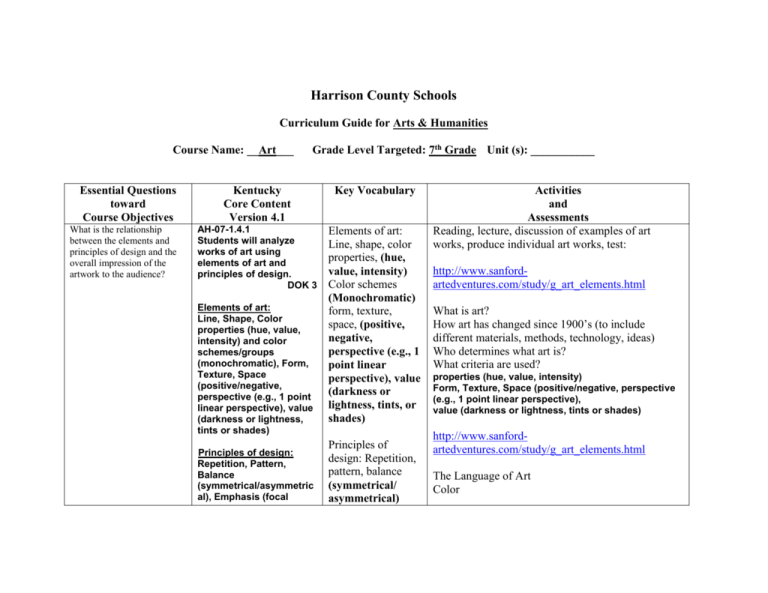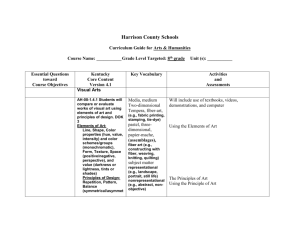Grade 7 - Harrison County Schools
advertisement

Harrison County Schools Curriculum Guide for Arts & Humanities Course Name: __Art___ Essential Questions toward Course Objectives What is the relationship between the elements and principles of design and the overall impression of the artwork to the audience? Grade Level Targeted: 7th Grade Unit (s): ___________ Kentucky Core Content Version 4.1 Key Vocabulary AH-07-1.4.1 Students will analyze works of art using elements of art and principles of design. DOK 3 Elements of art: Line, shape, color properties, (hue, value, intensity) Color schemes (Monochromatic) form, texture, space, (positive, negative, perspective (e.g., 1 point linear perspective), value (darkness or lightness, tints, or shades) Elements of art: Line, Shape, Color properties (hue, value, intensity) and color schemes/groups (monochromatic), Form, Texture, Space (positive/negative, perspective (e.g., 1 point linear perspective), value (darkness or lightness, tints or shades) Principles of design: Repetition, Pattern, Balance (symmetrical/asymmetric al), Emphasis (focal Principles of design: Repetition, pattern, balance (symmetrical/ asymmetrical) Activities and Assessments Reading, lecture, discussion of examples of art works, produce individual art works, test: http://www.sanfordartedventures.com/study/g_art_elements.html What is art? How art has changed since 1900’s (to include different materials, methods, technology, ideas) Who determines what art is? What criteria are used? properties (hue, value, intensity) Form, Texture, Space (positive/negative, perspective (e.g., 1 point linear perspective), value (darkness or lightness, tints or shades) http://www.sanfordartedventures.com/study/g_art_elements.html The Language of Art Color Essential Questions toward Course Objectives Kentucky Core Content Version 4.1 point), Contrast (e.g., black/white, rough/smooth), Rhythm, Proportion, Movement Key Vocabulary emphasis, (focal point), contrast, rhythm, proportion, movement Activities and Assessments balance (symmetrical/ asymmetrical) emphasis, (focal point), http://www.artsconnected.org/toolkit/ Using Color Combinations Line Shape, Form, and Space Texture Painting a Landscape http://www.walkerart.org/ace/ed_activities/units_i/w ac_l3i_private/index.html How is the use of particular art media related to the processes involved in making art with any particular media? How is the process of making AH-07-1.4.2 Students will describe a variety of art media and art processes. Media, medium Two-dimensional Tempera, fiber-art, (e.g., fabric printing, stamping, tie-dye) Explain “description” using elements Describing Art Works Describe a work of art using elements-assessed through test and open response Doodle drawing – line, shape, value, texture, focal point – pencil Review 2 pt. perspective – draw 25 boxes; city with buildings, streets sidewalks, signs, different facades. Painting – select a painting from art history to copy mixing own colors, tints and shades from primaries. http://cfmedia.scetv.org/artopia/ Painting : 1. Landscape - of own preference from observation Essential Questions toward Course Objectives artwork related to the end result of the design? Kentucky Core Content Version 4.1 DOK 2 Media (plural)/Medium (singular): (Properties of media need to be known in order to respond to artworks) Two-dimensional crayon, pencil, fabric, yarn, paint (tempera, watercolor), ink, pastel Three-dimensional - clay, papier-mâché, found objects (assemblages) Art Processes: Two-dimensional drawing, painting, fiber art (e.g., fabric printing, stamping, tie-dye), printmaking Three-dimensional ceramics, sculpture, fiber art (e.g., constructing with fiber, weaving, knitting, quilting) Subject matter: representational (e.g., landscape, portrait, still life) nonrepresentational (e.g., abstract, non- Key Vocabulary Activities and Assessments pastel, threedimensional, papier-mache, (assemblages), and fantasy 2. Still life – (several) from observation Sculpture 1. Papier maché – fish or other aquatic animal fiber art (e.g., constructing with fiber, weaving, knitting, quilting) http://www.albrightknox.org/ArtStart/ASimagesAI.HTM subject matter representational (e.g., landscape, portrait, still life) nonrepresentational (e.g., abstract, nonobjective) Essential Questions toward Course Objectives Kentucky Core Content Version 4.1 Key Vocabulary Activities and Assessments objective) How does the artists’ background and culture influence their style of expression and design (in art and architecture)? How does the time period related to the influence between diverse cultures artistic style of expression and design? AH-07-2.4.1 Students will analyze or explain how diverse cultures and time periods are reflected in visual arts. Classical Greece Logic, reason, moderation Western Civilization, Influence, DOK 3 architecture, Periods: Classical Greece – Presents the universal ideal of beauty through logic, order, reason and moderation. Western civilization was heavily influenced by Classical Greece. (architecture, sculpture, pottery) Ancient Rome – Continuation of Classical Greek traditions in the arts, advancement of architecture (Pantheon, Coliseum, arch, vault, dome) Ancient Egypt – Monumental structures (e.g., pyramids, sphinx), (architecture, sculpture, pottery) Ancient Rome: traditions, advancement (Pantheon, Coliseum, arch, vault, dome) Ancient Egypt: (e.g., pyramids, sphinx), Medieval: (Gothic and Romanesque architecture, basic characteristics and influence of Roman techniques) http://www.metmuseum.org/toah/splash.htm http://www.ibiblio.org/wm/paint/ The Art Experience Examining Art Works Artists and Ideas Making a Collage Classical Greece (art of Ancient Greece) Making a Painting for a Greek vase Art of Ancient Rome Art of Ancient Egypt Creating a Picture Story Art of the Romanesque Period Art of the Gothic Period Classical Greece Making a Painting for a Greek vase Thinkquest: http://library.thinkquest.org/C0118063/capsule.htm http://www.biggsmuseum.org/kids/whatisthis.htm Essential Questions toward Course Objectives Kentucky Core Content Version 4.1 Key Vocabulary Activities and Assessments visual arts reflect religion and belief in immortality Medieval – Appeals to emotions and stresses the importance of religion. (Gothic and Romanesque architecture, basic characteristics and influence of Roman techniques) AH-07-3.4.1 Students will identify or explain how art fulfills a variety of purposes. DOK 2 Purposes of Art: (different roles of art) Ceremonial - ritual, celebration, artworks created to support worship ceremonies Artistic expression artwork to express or communicate emotions, ideas, feelings (e.g., for self-expression, to decorate or beautify objects) Narrative - artworks that Purposes of Art (different roles of art) ceremonial, ritual, worship, artistic expression, narrative, functional, persuasive, philosophies, http://www.eduweb.com/pintura/ http://www.kn.pacbell.com/wired/art2/index.html Art History: http://www.eduweb.com/insideart/ Compare and Contrast Art: http://www.behindtheglass.org/activities/compare. asp http://www.metmuseum.org/home.asp http://www.artic.edu/aic/ http://www.mfa.org/home.htm http://americanart.si.edu/index3.cfm http://www.lacma.org/ http://www.nga.gov/ http://www.louvre.fr/llv/commun/home_flash.jsp?bmL ocale=en http://www.tate.org.uk/ http://www.nationalgallery.org.uk/ http://museoprado.mcu.es/ihome.html http://www.hermitagemuseum.org/html_En/index.html http://www.virtualmuseum.ca/Exhibitions/allensapp/ http://www.virtualmuseum.ca/Exhibitions/ScholarGard en/tour/index.php3?usr=n5|true|true|eng Essential Questions toward Course Objectives Kentucky Core Content Version 4.1 tell stories, describe and illustrate experiences, or communicate ideas or information, art to document important or historical events Functional - artistic objects used in everyday life Persuasive - artworks that promote ideas, philosophies, or products (e.g., advertising, marketing, propaganda, ideology, etc.) AH-07-4.4.1 Students will create art for specific purposes using the elements of art and principles of design to communicate ideas. AH-07-4.4.2 Students will use a variety of art media, processes and subject matter to communicate ideas, feelings and experiences. Key Vocabulary Activities and Assessments (e.g., for self-expression, to decorate or beautify objects) (e.g., advertising, marketing, propaganda, ideology, etc.) Principles of design http://www.seattleartmuseum.org/myartgallery/ Doodle drawing – line, shape, value, texture, focal point – pencil Review 2 pt. perspective – draw 25 boxes; city with buildings, streets sidewalks, signs, different facades. Painting – select a painting from art history to copy mixing own colors, tints and shades from primaries. Media, processes, subject matter Painting : 1. Landscape - of own preference from observation and fantasy 2. Still life – (several) from observation Sculpture 1. Papier maché – fish or other aquatic animal








